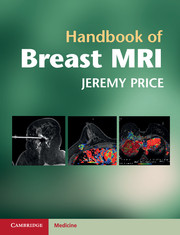Book contents
- Frontmatter
- Contents
- Preface
- Acknowledgements
- Glossary
- Abbreviations
- 1 Basics of breast MRI
- 2 Imaging-related anatomy and pathology
- 3 Interpreting breast MRI studies
- 4 MRI-guided biopsy techniques
- 5 High-risk screening using breast MRI
- 6 Preoperative staging with breast MRI
- 7 Problem-solving applications of breast MRI
- 8 MRI after breast augmentation
- Answers to multiple choice questions
- Appendices
- Index
- Plate section
- References
2 - Imaging-related anatomy and pathology
Published online by Cambridge University Press: 05 March 2012
- Frontmatter
- Contents
- Preface
- Acknowledgements
- Glossary
- Abbreviations
- 1 Basics of breast MRI
- 2 Imaging-related anatomy and pathology
- 3 Interpreting breast MRI studies
- 4 MRI-guided biopsy techniques
- 5 High-risk screening using breast MRI
- 6 Preoperative staging with breast MRI
- 7 Problem-solving applications of breast MRI
- 8 MRI after breast augmentation
- Answers to multiple choice questions
- Appendices
- Index
- Plate section
- References
Summary
Chapter outline
Introduction
Breast anatomy
Basic mammography and breast ultrasound
Review of breast histopathology
Molecular classification of breast cancer
Mammographic correlates of pathologic subtypes
Mammographic correlates of molecular subtypes
Introduction
While a basic level of knowledge is assumed, this chapter offers a brief review of breast anatomy, conventional breast imaging and breast pathology as useful background information to subsequent chapters. Over the last decade, the new molecular classification of breast cancer has assumed increasing clinical importance and has improved our understanding of pathogenesis. There is a developing appreciation of the concept that tumor biology may be more important in determining clinical outcomes than tumor burden. The concept of a broad division into low-grade and high-grade pathways of breast cancer development has important implications for management at a time when it is increasingly recognized that over diagnosis and overtreatment are significant issues in breast cancer screening programs. Some correlations between mammographic appearances and tumor pathology are highlighted, which are particularly pertinent in relation to BRCA gene mutation carriers, a high-risk subgroup where the use of screening MRI is becoming routine.
- Type
- Chapter
- Information
- Handbook of Breast MRI , pp. 22 - 47Publisher: Cambridge University PressPrint publication year: 2011



